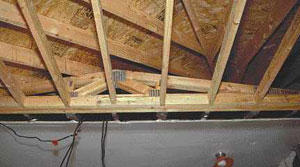Business Articles - On the Job
Articles & Tips

We all know what happens when you put an addition on a home and what once was an exterior bearing wall ends up in the middle of the room: You either drop a beam below the ceiling or, if you have the space (and the budget), you retrofit a flush beam up into the ceiling (below).

Here's another simple solution that you might consider when it fits: Use a special-order girder truss designed (often for free, by the truss company) to carry the loads.
In the project shown above, the existing drywall ceiling stops where the exterior wall used to be. The old joists and rafters, visible just beyond the edge of the drywall, originally landed on the wall. But instead of a beam, which would have dropped below the ceiling, the remodeler installed the girder truss. Note that because it tapers at the end — like any roof truss — it can fit in the short space at the eaves where a beam might not fit. It's lighter than a solid beam would have been, too, making the lifting a little easier. — David Frane
Outdoor Detour
by David WestRecently, some clients called to ask about having a home theater installed in the unfinished attic of their beautifully furnished home. I immediately pictured my crew tromping through the house and up the stairs, hauling tools and materials up and down for several weeks, and knew if I weren't careful I'd have a public relations disaster on my hands.
The idea I came up with to avoid this scenario was a temporary three-story staircase [1] built on top of the exterior deck and leading up through a new window opening retrofitted in the attic's shed dormer wall. I sketched it out and calculated the materials and labor it would require — about $3,000 — and included it as a line item in my estimate. My clients were impressed and quickly accepted the concept and the cost, and my crew went to work.
1 
We used LVL for the stringers and 2x12s for the treads, which rested on nailed-on cleats. Two-by-four handrails provided security on both sides. The upper stair rested against a level work platform built on the roof in front of the new opening; the platform was protected by a plywood guard rail [2].
2 
A shorter flight of stairs led down from the window sill into the attic space [3]. The stairs took a two-man crew two days to build, but I know I saved more than that in time that otherwise would have been spent protecting surfaces and negotiating bulky materials through the interior of the house.
3 
On the downside, we had to haul all our materials, tools, and cabinets to the back of the house and up the stairs. To keep my regular crew productive, I hired day laborers to do the heavy hauling, and brought them back again to load the blue board once it was time for plaster.
At the end of the job, we installed the window in the opening we'd been using for access, then dismantled the stair. We ended on schedule, with my clients very appreciative that no worker ever had to set foot in the main part of the house.
David West owns Meadowview Construction in Topsfield, Mass.
This article has been provided by www.jlconline.com. JLC-Online is produced by the editors and publishers of The Journal of Light Construction, a monthly magazine serving residential and light-commercial builders, remodelers, designers, and other trade professionals.
Join our Network
Connect with customers looking to do your most profitable projects in the areas you like to work.

